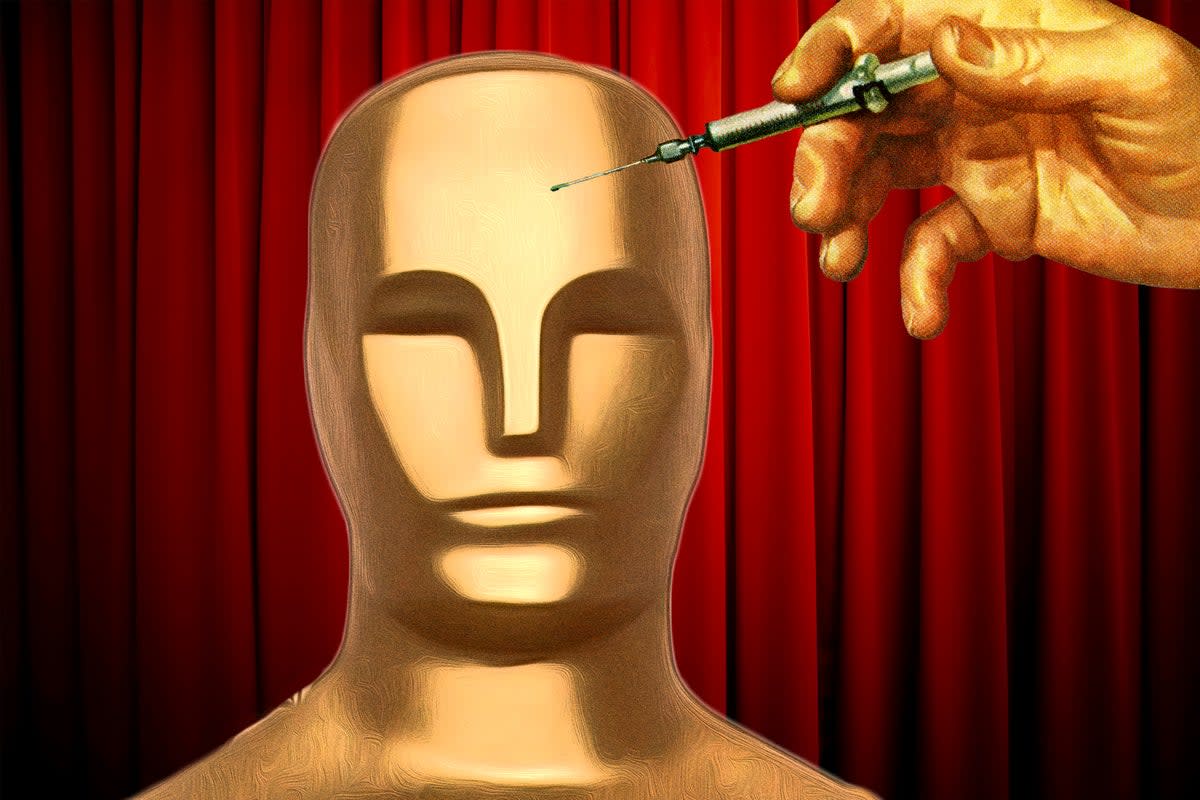Plastic surgery is ruining Hollywood – and most movie stars aren’t willing to talk about it

This month, Netflix is releasing a film with a very famous movie star who has had some of the most egregious plastic surgery I’ve ever seen on a man. This actor has been around for a few decades now, but his face is comparatively newborn. His cheeks are fuller. His jaw is unusually square. His skin bears an uncanny shine. Because of how we’ve been conditioned to talk and not talk about celebrity “tweakments”, I cannot name this man, nor the film he’s in. But when you and your family are huddled around the TV this Christmas and watching one of the streaming platform’s key Oscar hopefuls, at least a few of you will probably ask the same thing: “Has he had something done?”
To watch a modern movie or television show is to watch a sea of often identikit faces that have been pulled, tweaked and injected. It is distracting and regularly incongruous, clashing with what we already know about characters (is no one going to talk about the Marvel superhero who seemed to get an enormous jaw implant between sequels?), and sometimes it’s historically inaccurate, too (they had Botox and fillers in the era of Oppenheimer? Who knew?!).
It’s not something that gets discussed outside of gossip blogs and your desk at work, though. A code of silence seems to exist in modern critical discourse, where elective plastic surgery is unfairly lumped in with discussion about looks or weight – two topics that are rarely relevant to any legitimate sort of criticism, and more often than not become means to be pointlessly cruel. But when a thick lick of Botox not only censors an actor’s ability to emote, but also completely takes you out of a film – is it not right to call it what it is?
A litmus test for this kind of discourse occurred in 2007, when the celebrated film critic Stephanie Zacharek watched Noah Baumbach’s dark comedy Margot at the Wedding and came away with one major thought: “What has Nicole Kidman done to her face?” In her review, published in Salon Magazine, Zacharek acknowledged Kidman’s then-recent insistence that she is “completely natural”, before writing: “It’s disingenuous to pretend not to notice any change. Kidman’s skin is, without a doubt, beautiful. But it has turned into her greatest limitation, a boundary beyond which she can’t stretch.” She then dedicated several sentences to a scene in the film in which Kidman made “great effort” to “furrow her brow”.
Even now, and wherever you stand on the accuracy or relevance of Zacharek’s criticism, it’s hard not to wince at the boldness of putting these thoughts in print. For some reason, it feels so much more brutal when it’s put so eloquently, versus in a sensational headline on a tabloid newspaper’s “sidebar of shame”. Or rattled out by some random-er on X/Twitter called BonerDude92.
Zacharek’s review sparked fervent debate at the time it was published, and to this day is typically associated – as in a reappraisal of Kidman’s career published by Buzzfeed in 2017 – with a strain of Noughties online cruelty that we’re apparently well shot of now. You won’t see much like it in modern reviews of the latest releases. But Zacharek did have a bit of a point, if not with Kidman – who is so good at what she does that she could act from underneath a breeze-block of wax and still be marvellous, frankly – then at least with the creeping expectation that we ought to get used to actors acting while more or less embalmed.
There are, of course, understandable reasons why movie stars seek cosmetic treatments – Hollywood is brutal, a system built on ageism, sexism and rampant paranoia, where someone younger and cuter is always waiting in the wings to replace you. But there has to be a happy medium, where actors can temporarily inject themselves with anything they like for red carpets and photo shoots, but also allow the effects to settle or dissolve by the time they hit set. Nothing is more ruinous to a film’s credibility – and often an actor’s sheer talent – than a star fighting through layers of an injectable. And, for the love of God, at least be open about it if it goes wrong.

I was pleasantly surprised, for instance, when earlier this year the Sex and the City star Kristin Davis acknowledged that she’d had work done – therefore making it less problematic for us all to talk about. I had spent much of the first season of the show’s sequel And Just Like That distracted by Davis’s face, which looked artificially different in a way I couldn’t quite put my finger on. Davis is a brilliant actor, and the changes to her face – which also impacted her comic elasticity and sheer ease on screen – made me sad. Speaking to The Telegraph, Davis admitted that she’d had to get fillers dissolved after they’d been injected poorly, adding: “I’ve been ridiculed relentlessly. And I have shed tears about it. It’s very stressful.” She said that originally no one told her that her lip injections “didn’t look good… luckily I do have good friends who did say eventually”.
Once I read Davis’s interview and began watching And Just Like That season two, I stopped noticing the work she’d had done. Because I had context – that it wasn’t intentional, and that Davis knew it had gone wrong and been made to feel terrible for it – it didn’t bother me any more. It didn’t feel like an elephant in the room that absolutely no one was addressing. It also made me realise the issue with so much celebrity plastic surgery is the ambiguity of it all – that sensation of knowing something is different about the face of someone you’ve been watching for years, but not being able to quite identify what it is.
Plastic surgery or other kinds of cosmetic maintenance aren’t things to be ashamed of, and it doesn’t demystify the glamour of Hollywood to admit that your face wasn’t carved by the gods but by Dr Eyelift, MD. But context matters! If you’re starring in an expensive Oscar movie set decades ago, maybe avoid looking like a living Instagram filter. Or at least own up to it, if only so we can all avoid those lengthy debates about which parts of an actor’s face are real and which are toxins.

